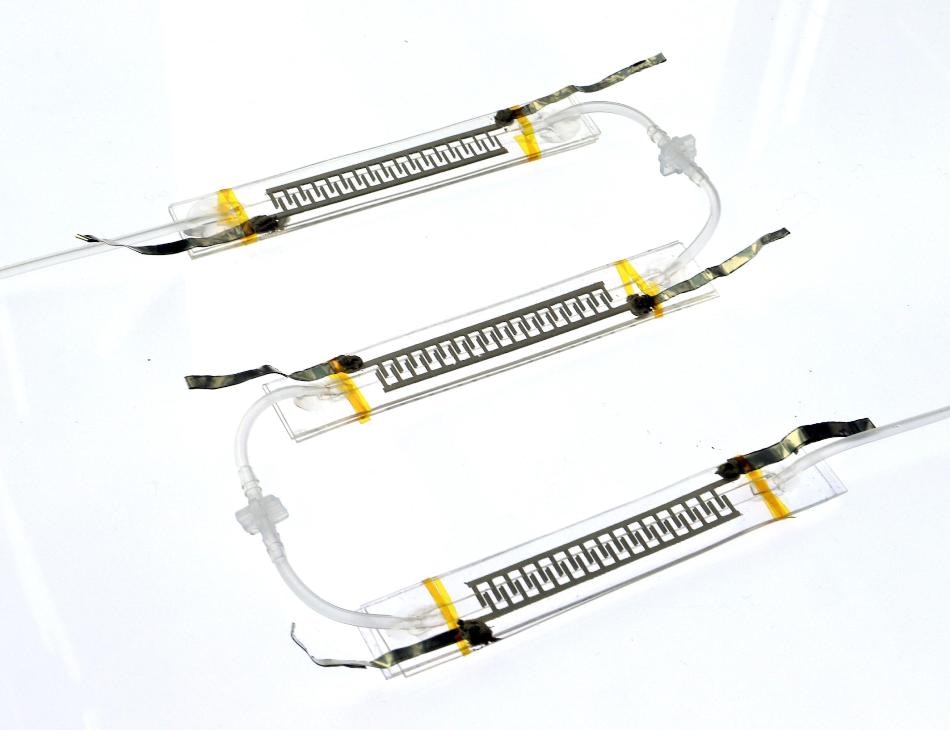Aug 19 2019
EPFL scientists have created an innovative, tiny pump that is believed to play a major role in the development of smart clothing, lightweight exoskeletons, and autonomous soft robots.
 Three pumps in series (Image credit: Vito Cacucciolo/2019 EPFL)
Three pumps in series (Image credit: Vito Cacucciolo/2019 EPFL)
The pump is silent, flexible, and weighs just 1 g. It may soon substitute the bulky, stiff, and noisy pumps that are presently utilized. The study results were recently reported in Nature.
Soft robots, when compared to their stiff forebears, offer a clear advantage. For example, they can handle delicate objects, adjust to challenging environments, and communicate safely with humans.
The robots are made from rubber, silicone, or similar stretchable polymers, and are perfect for use in robotic clothing and rehabilitation exoskeletons. One day, soft bio-inspired robots would be deployed to study risky or remote environments.
Noisy pumps actuate a majority of soft robots, pushing fluids into the moving parts of the machines. Since these robots are coupled to these large pumps through tubes, they tend to have reduced autonomy and are awkward to wear at best.
Cutting Soft Robots’ Tether
At EPFL’s Soft Transducers Laboratory (LMTS) and Laboratory of Intelligent Systems (LIS), a research team in association with scientists at the Shibaura Institute of Technology in Tokyo, Japan, has created an entirely soft pump for the first time. Even the electrodes in this pump are flexible.
Weighing only 1 g, the new pump is completely noiseless and consumes only minimal power, which it obtains from a 2 cm x 2 cm circuit featuring a rechargeable battery.
If we want to actuate larger robots, we connect several pumps together.
Herbert Shea, Director, LMTS, School of Engineering, EPFL
The soft and stretchable pump can rid soft robots of their tethers.
“We consider this a paradigm shift in the field of soft robotics,” added Shea. The scientists have recently published an article on their work in the Nature journal.
Moreover, the soft pumps can be utilized to circulate liquids in thin flexible tubes integrated into smart clothing, resulting in garments that can actively heat or cool different parts of the body. That would help in meeting the requirements of pilots, athletes, and surgeons, for instance.
How Does it Work?
The innovative pump is built on the physical mechanism that is currently used to circulate the cooling liquid in supercomputers and similar systems. The pump includes a tube-shaped channel that measures 1 mm in diameter, and within these channel, rows of electrodes are printed.
A dielectric liquid has been used to fill the pump. Upon applying a voltage, electrons move from the electrodes to the liquid, providing an electrical charge to some of the molecules. Subsequently, these molecules are attracted to other electrodes and pull along the rest of the fluid through the tube with them.
We can speed up the flow by adjusting the electric field, yet it remains completely silent.
Vito Cacucciolo, Study Lead Author and Post-Doc, LMTS, EPFL
Developing Artificial Muscles in Japan
The team has effectively implanted the pump in a type of robotic finger that is extensively utilized in soft robotics laboratories. At present, the researchers are working with Koichi Suzumori’s laboratory in Japan, which is in the process of designing flexible exoskeletons and fluid-driven artificial muscles.
In addition, the EPFL scientists have included tubes in a fabric glove and demonstrated how the pump could be used for heating or cooling the glove regions as required.
“It works a little like your home heating and cooling system” stated Cacucciolo. Several companies have already shown an interest in this application.
A miniature stretchable pump for the next generation of soft robots
(Video credit: EPFL)